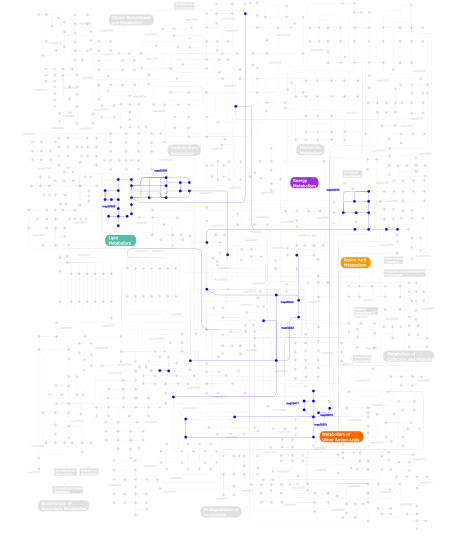The domain within your query sequence starts at position 10 and ends at position 348; the E-value for the Asparaginase domain shown below is 2.67e-111.
RLLAIYTGGTIGMRSEGGVLVPGRGLAAVLKTLHMFHDEEYAQAHSLPEDTLVLPPASPD QRIIYTVLECQPLFDSSDMTITEWVQIAQTIERHYAQYQGFVVIHGTDTMAFAASVLSFM LENLQKPVVLTGAQVPIHALWSDGRENLLGALLMAGQYVIPEVCLFFQNQLFRGNRTTKV DARRFAAFCSPNLPPLATVGADVTINRELVRKACGKSHLVVHSSMEPDVGLLRLYPGIPA SLVRTFLQPPLKGVVMETFGSGNGPTKPDLLQELRVAAEQGLIIVNCTHCLQGAVTSDYA SGMAMAGAGIVSGFDMTSEAALAKLSYVLGQPGLSLNDR
Asparaginase |
|---|
| SMART accession number: | SM00870 |
|---|---|
| Description: | Asparaginase, which is found in various plant, animal and bacterial cells, catalyses the deamination of asparagine to yield aspartic acid and an ammonium ion, resulting in a depletion of free circulatory asparagine in plasma (PUBMED:3026924). The enzyme is effective in the treatment of human malignant lymphomas, which have a diminished capacity to produce asparagine synthetase: in order to survive, such cells absorb asparagine from blood plasma (PUBMED:2407723), (PUBMED:3379033) - if Asn levels have been depleted by injection of asparaginase, the lymphoma cells die. |
| Interpro abstract (IPR006034): | L-Asparaginases ( EC 3.5.1.1 ) hydrolyze L-asparagine to L-aspartate and ammonia. Enzymes with asparaginase activity play an important role in the metabolism of all living organisms [ (PUBMED:11996000) (PUBMED:17143335) ]. Enzymes capable of converting L-asparagine to L-aspartate can be classified as bacterial-type or plant-type L-asparaginase. Bacterial-type L-asparaginase are further divided into subtypes I and II, defined by their intra-/extra-cellular localization, substrate affinity, and oligomeric form. Homologous bacterial-type L-asparaginase are found in all kingdoms of life. Furthermore, bacterial-type L-asparaginase are related to other enzymes, including:
|
| Family alignment: |
There are 19043 Asparaginase domains in 19037 proteins in SMART's nrdb database.
Click on the following links for more information.
- Evolution (species in which this domain is found)
- Cellular role (predicted cellular role)
- Literature (relevant references for this domain)
- Metabolism (metabolic pathways involving proteins which contain this domain)
- Structure (3D structures containing this domain)
- Links (links to other resources describing this domain)























































